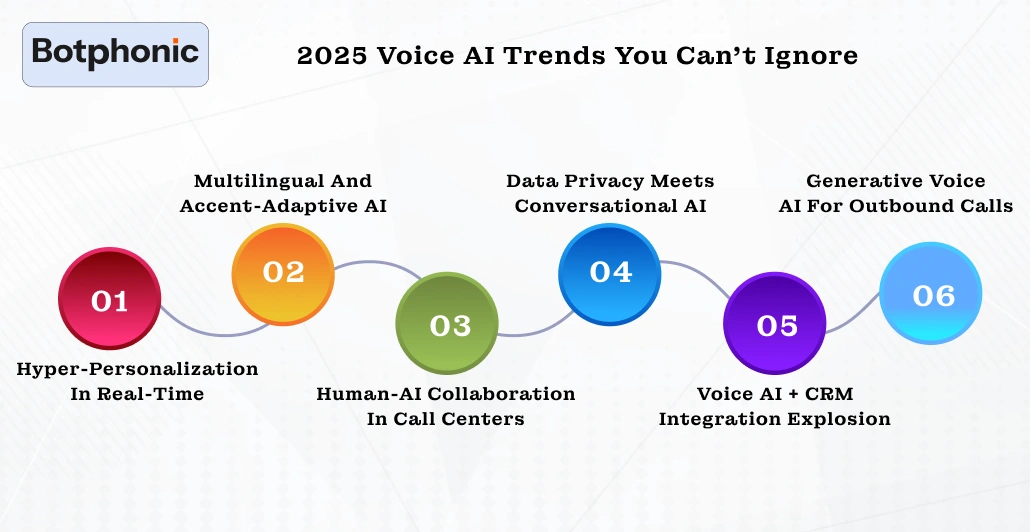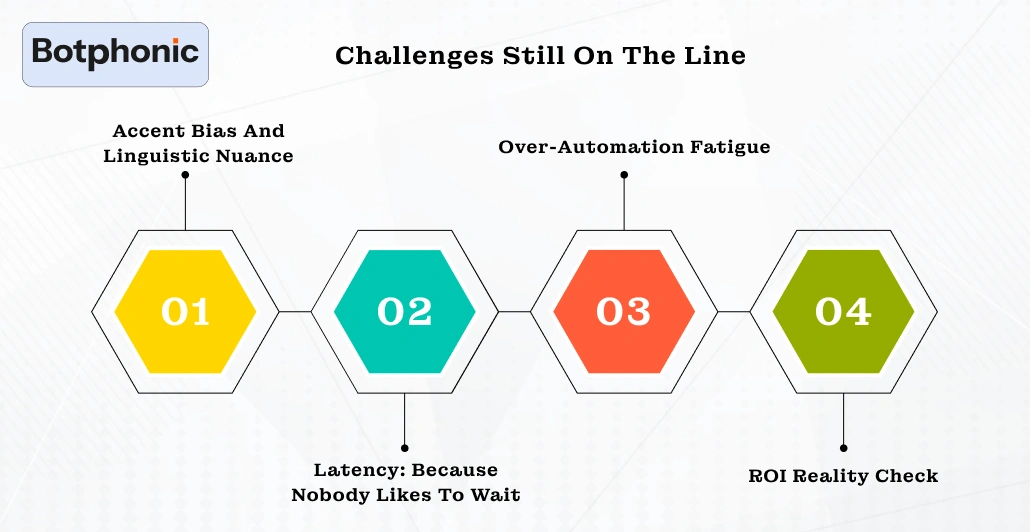
Summarize Content With:
Quick Summary
In this blog, we will discover how AI phone calls have become mission-critical. It’s no longer just a future concept but has become the backbone of modern customer communication. We will read how personalization has become a new currency and how human-AI collaboration is winning across the industries.
We will uncover how the future belongs to brands that can blend data-driven intelligence with human-grade warmth.
Introduction
Thinking about those old days might give you some stress. Remember when calling customer service meant a longer journey of holding music and robotic menus? But no issues, those days are on the verge of getting extinct.
In 2025, AI phone call are no longer gizmos; but they have become an essential tool. Voice AI has matured, and it no longer relies on clunky scripts; instead, it thinks, remembers, and responds like a seasoned professional. If your business still depends on that “press 1…” you are already a step behind your competitors.
From IVR to Intelligent Conversation: The Evolution of Voice AI
Let’s just take a quick look at the past and see how things have changed.
In earlier times, IVR systems used to request you to press several buttons just to resolve one query, even though they could handle volume, but they weren’t able to offer quality service. And now, we have conversational AI, which is powered by NLP and sentiment analysis. These evolved systems can easily identify context, intent, and even emotion behind the user’s query.
But the future of these systems is going to be totally contextual, and predictive systems won’t just remember your phone number but the whole interaction made in the past. This transformation from “slow menus” to “smart and intelligent dialogues” is the distinction line for yesterday’s customer experience and tomorrow’s competitive advantage.
2025 Voice AI Trends You Can’t Ignore

1. Hyper-Personalization in Real-Time
Today’s callers are expecting something more than just quick answers; they are asking to be understood. Voice AI systems are now designed so they recognize returning customers, recall previous interactions, and adapt their tone accordingly. Just imagine being greeted with, “Welcome, John. About that refund from last week…” instead of receiving some cold and generic prompt.
If we think of it as business logic, personalization refers to loyalty. It directly reduces repeat calls, boosts satisfaction, and builds trust.
2. Multilingual and Accent-Adaptive AI
The global marketplace speaks every language one can imagine. In 2025, top Voice AI models are able to recognize accents, switch languages mid-sentence, and even localize slang.
And do you know why this actually matters? Because now you can easily scale globally without scaling payroll. Just a single AI system can help you handle Spanish, Indian, French, German, etc, callers with human-like fluency. There won’t be any lost translation or lost customers.
3. Human-AI Collaboration in Call Centers
Contrary to those doomsday headlines that “AI will take your call-center jobs,” don’t worry, it isn’t. AI call assistant are only making it easier for them to manage high call volumes smartly.
Agents are now working with AI as a co-pilot, who listens, summarizes, and suggests actions in real-time.
You can just think that, while talking to a customer, there’s an AI whispering: “The customer sounds frustrated, offer a discount.” What do you think the result will be? It’s faster resolution, fewer errors, and more genuine human conversations.
4. Data Privacy Meets Conversational AI
Voice data is really sensitive, much more than just some written paper. 2025’s regulatory landscape is just getting stricter with its compliance laws.
Ethical voice AI now includes:
- Explicit consent prompts before initiating data recording.
- Encryption is added for all stored calls.
- Voice-cloning transparency.
- Bias and fairness checks
Always remember that trust is the currency of the voice economy; without it, the line will just go dead.
5. Voice AI + CRM Integration Explosion
Voice systems are no longer working alone. They are plugged directly into CRM systems like Salesforce, HubSpot, and ServiceNow.
A modern AI agent can:
- Pull customer data from the system before answering.
- Logs summaries into the CRM automatically.
- Triggers workflow or follow-ups without requiring human input.
6. Generative Voice AI for Outbound Calls
AI phone call agents have become the new bold frontier; they are new synthetic sales agents.
Generative AI can now produce natural and emotionally intelligent voices for outbound calls. They can now follow scripts dynamically, adapt mid-conversation, and even use humor appropriately.
Even though generative AI is the key, one should ensure it’s not getting abused. Nobody likes to chat with a soulless robotic telemarketer. You can use AI for initial outreach or surveys, and when required call can be transferred to humans for complex or emotional moments.
Industry Spotlight: Who’s Leading the Voice AI Charge
- Telecom and Utilities – Numerous high-volume and repetitive queries can be automated instantly with AI-powered phone systems. Even voice AI handles outage updates, billing, and plan upgrades, which frees up agents for exceptions.
- Healthcare – Appointment reminders, prescription refills, and even early health detection can be done via voice biomarkers. It’s designed with empathy and efficiency, that the perfect blend required for enhanced service.
- Finance – Voice biometrics, fraud detection, and real-time account support are increasing day by day. Customers are inclined to trust voice more than chat when it comes to their money.
- Retail and E-Commerce – Voice commerce is increasing rapidly. “Order my usual meal” is no longer just an imaginary dream; but it has become a sales automation via voice.
Challenges Still on the Line

Every technology has its pros and cons, and, of course, VoiceAI in 2025 is no exception. The promises are remarkable: automation, empathy, and efficiency, but the reality is that it is still in development. One of the main points of friction between businesses and consumers that they should not ignore is the following:
1. Accent Bias and Linguistic Nuance
Voice AI may still have difficulties with thick accents, slang, or regional idioms. Sometimes, these aspects might even be the downfall of the smartest models. A person calling from Glasgow or Chennai may leave your system as perplexed as a GPS in a tunnel.
Fix: The model has to be retrained continuously with voice datasets representing different accents.
2. Latency: Because Nobody Likes to Wait
A delay of just a few seconds is perceived as an eternity by the customer. The customers subconsciously assign the delayed response to being incapable of handling the situation. Even the most understanding AI voice will be considered untrustworthy if it talks with unnecessary pauses before every answer.
This can be solved by giving priority to low-latency infrastructure and edge processing. In voice AI, make sure that speed is the partner of empathy.
3. Over-Automation Fatigue
Everyone is fond of efficiency, but no one is willing to have a 10-minute conversation with a robot about their missing shipment. Customers are always looking for prompt resolution, and sometimes, only a human can provide that emotional closure.
You may always merge automation with escalation. Let AI deal with the simple tasks while also ensuring that there is an “escape hatch” for calls to humans whenever the situation gets emotional or too complex.
Start by auditing your call journey and let AI phone call agent bridge the gap.
Try Botphonic Today!!4. ROI Reality Check
Deploying voice AI isn’t some budget fairytale. Licenses, integrations, retraining, and maintenance add up. CFOs are just asking the hard questions: What’s the payback period? Are we cutting costs or just creating new ones?
You should treat voice AI as a transformation project, not just a gadget purchase. Start small, measure KPIs, and lastly scale after knowing what works.
Voice AI is one of the brilliant assets, but it isn’t bulletproof. Successful organizations often approach this with clear ambitions; they combine technological ambition with operational humility.
Conclusion
In 2025, AI systems will have evolved from clunky IVR menus to intelligent, multilingual, and emotionally aware communication systems. The leading voice AI trends such as hyper-personalization, accent adaptability, CRM integration, and generative outbound calls. These are reshaping how organizations are connecting with customers.
However, innovation in AI voice call assistant brings its own checklist of challenges. For instance, accent bias, latency, over-automation, and ROI skepticism are forcing leaders to balance speed with sensitivity.

